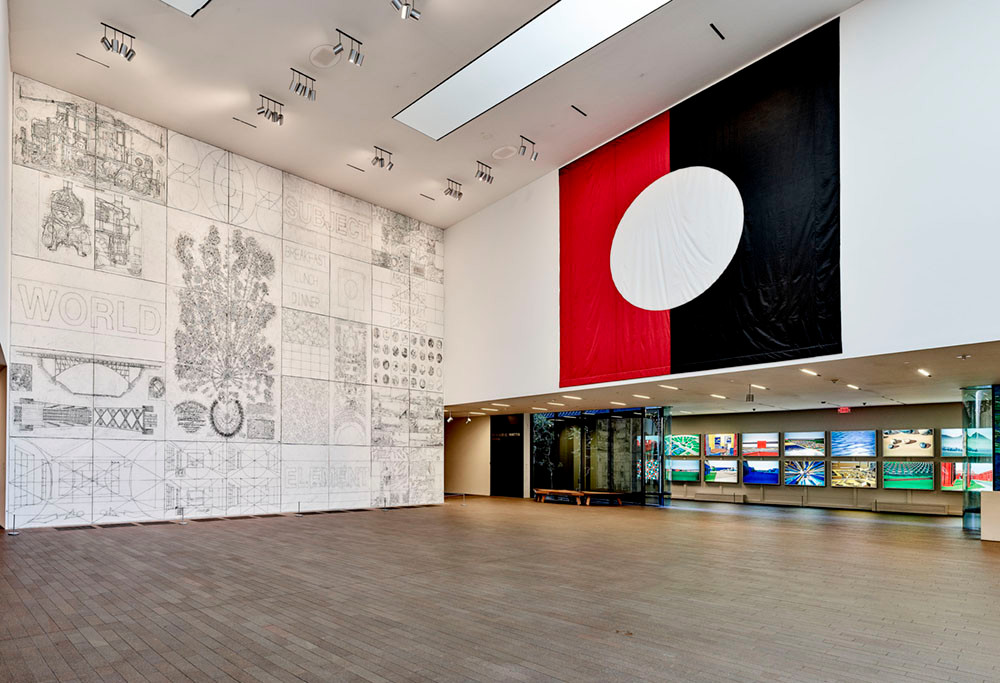[ad_1]
Around 1980, Matt Mullican began visually elaborating a cosmology of his own invention, for which he divided reality into five color-coded orders of being. The lowest order in the hierarchy, given the color green, was the elemental, material base of existence. This was followed by the domains of everyday life (blue); culture and science (yellow); language and representation (black and white); and subjectivity (red). To each of these he assigned a different pictographic symbol reminiscent of the schematic directional icons one might find in airports or on restroom doors. In time, his iconography expanded to incorporate more specific phenomena, some ordinary (food, shelter, music, film) and others mystical (life, death, fate, god). Mullican has featured various combinations of his symbols in a range of formats, including bulletin board displays, posters, flags, banners, light-box transparencies, sand-blasted stone reliefs, and canvas rubbings.
Photo Randy Dodson.
Several of these types of work appear in the de Young’s “Between Sign and Subject,” a small retrospective that serves as the California-born, largely Europe-based artist’s first solo exhibition at a United States museum in twenty years. On view, for instance, are four of his bulletin boards from the early 1980s, each featuring tacked-up items relating to an aspect of his cosmological system. Untitled (Household), 1982, displays sheets, napkins, buttons, and the like—tokens from the zone of everyday life. Untitled (Bulletin Board: comics), 1982, for its part, addresses the order of language and representation by compiling images excised from comic-book panels and categorizing them according to their content or theme. The exhibition also includes a large flaglike banner composed of red and black halves superimposed with a central white circle (presumably representing the nexus of subjectivity and language), and a series of lightbox transparencies from the late ’80s depicting computer-generated designs for an imagined city laid out in five color-coded districts corresponding to Mullican’s cosmological orders. When taking such forms, Mullican’s symbology can, as skeptical critics have observed, emit a noxious whiff of totalitarian pageantry and control.
The centerpiece of the show is a new work, Living in That World (2018), comprising forty oil stick–on–canvas rubbings, each almost seven feet square, installed in a grid that covers the museum’s southwest atrium wall. The rubbings, made using etched glass panels that the artist produced for this purpose, feature a variety of images. Some of the imagery is Mullican’s own, and some he appropriated. An ornate nineteenth-century diagram mapping the New York and Erie Rail Road company’s organizational structure appears alongside one of Mullican’s early, similarly diagrammatic cosmological sketches depicting the emergence of human culture from a chaotic elemental landscape. Found engineering plans, architectural projections, cartoon image fragments, and a chart with the Roman alphabet and Arabic numerals occupy other cells in the mural-scale grid. Three words displayed along the installation’s periphery—WORLD, SUBJECT, and ELEMENT—offer something of an interpretive key to the imagery. With so few works in the show to provide context, however, such a legend is likely decipherable only to viewers already well familiar with Mullican’s idiosyncratic taxonomy.
What, then, can an uninitiated visitor expect to take away from this exhibition’s small slice of Mullican’s world? The introductory wall text proposes that the artist’s sign system should be considered an “early embrace” of the type of “visual emblems that populate and obsessively draw us to the screens of our smartphones.” Although anachronistic, the allusion to Silicon Valley is nonetheless illuminating. Mullican’s work models the systematization of knowledge—scientific, bureaucratic, linguistic, mythological, and otherwise—through which humankind orders its reality: an endeavor, his flags and urban designs suggest, that is never divorced from politics and power.
This article appears under the title “Matt Mullican” in the December 2019 issue, pp. 98–99.
[ad_2]
Source link


